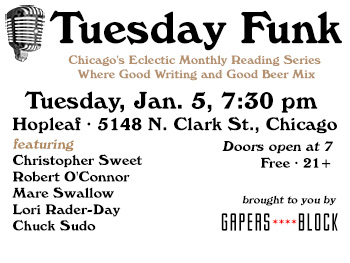| « Back to School with Reading Under the Influence | Chicago Public Library Amnesty Ends Friday » |
Interview Wed Sep 05 2012
Blue Balliett on Writing for Kids, and Everyone Else
Hyde Park resident Blue Balliett has a new book coming out this fall under Scholastic, and although she isn't yet free to discuss the specifics of her new creation, she was most willing to tell us about her writing life. And it's one to learn from as she's found great success as a New York Times Best Seller for her first Novel Chasing Vermeer, and great success with the others, too:
How does your writing process begin?
I do a couple of years of extensive reading, poking around before each books. 
Are there things you keep in mind as you're writing that you think might benefit other writers, too?
The one thing I try to keep in mind all the time when I'm writing is to make sure every detail has a reason to be in the story. You want to show people what's important through what characters are doing; what's going on will show who that person is. It's the idea of showing instead of telling, and that's why all of your details must matter. That's always one of the hardest one of the hardest things to remember because you get excited about throwing a twinkly detail in.
Now you are a full time writer, but how did you balance writing, teaching, and caring for your family before writing became a full time thing?
I think its really challenging. I had done some writing before our kids were born, and once they were born, but once I began teaching I didn't write anything for a long time. Writing was something I thought about all the time, though, and we'd make up stories together. It didn't occur to me that I had the energy to write.
Eventually I incorporated my writing into my teaching. One year, for instance, I had group that was really interested in art. We read The Mixed Up Files of Mrs. Basil E. Frankweiler and they said to me, you have to find us another book like that. The fact that it was set in a real place and had real ideas about art was really exciting to them and when I couldn't find another book quite like it, Chasing Vermeer began to develop. We actually did all the assignments that characters in Chasing Vermeer do.
Teachers don't have a lot of places to unpack the excitement of the classroom that you watch as a teacher as kids learn. I began to realize it was so much fun to have a place to put what I was learning from kids.
I am so fascinated by your atypical characters, primarily Zoomy who, for readers who aren't familiar, is disabled by eye condition. Is it important to you to make kids with untold stories the focus of your narratives?
Danger Box happened because I had learned about Charles Darwin's missing notebook. I went out and bought five bios of Darwin and was so excited to learn about what a strange child he was--he hated school, wasn't good at it, wasn't considered bright. He was dreamy, wouldn't do his homework, couldn't do anything he didn't want to do, and just wanted to collect and organize natural specimens. He was considered a real oddball, and also had some real anxiety issues. So the more I read, I realized, if he had been sent to school in this day and age he would have been labeled special needs--this was a person couldn't do school, who was not considered gifted in anyway, but became a thinker who changed the world.
That really lead to thinking, boy I'd like my main character to be somebody with special needs that perhaps would traditionally be looked at as weakness. Zoomy sees everything up close, which means he looks more carefully, and this gives him the ability to solve this mystery. Kids with normal perception couldn't see what he does.
The idea for Zoomy's eye condition came about when people were going door to door for Obama during the 2008 election. Somebody came and rang my bell in Hyde Park and there was a very interesting child with his mother. She told me about his eye condition and right away, I went to an eye doctor at the University of Chicago and got her to put lenses on me to see what things might look for someone with this condition. I got in his head.
What makes young readers different than adult readers do you think?
We've been trained to have knee jerk ability to separate and compartmentalize everything we experience--important or not important--but for a child, those boundaries aren't there yet, which makes for really interesting perception.
In Chasing Vermeer I play a lot with coincidence for this reason. Kids see things happening and try to make connections where adults wouldn't. They try to make things, even small things, meaningful. They have a freshness and ability to weigh everything equally that you really lose as you grow up.
I truly love writing for kids.









